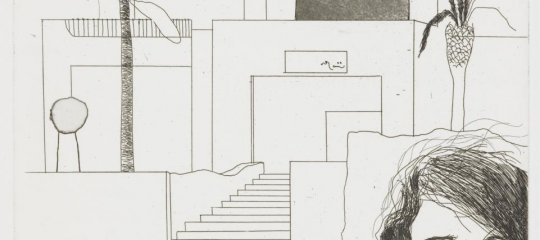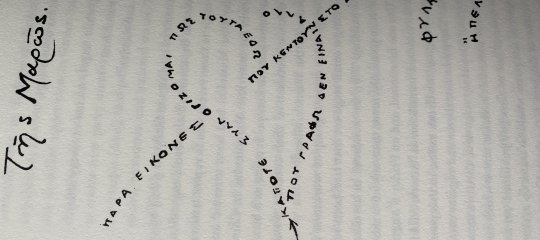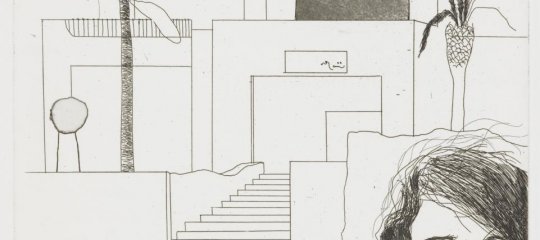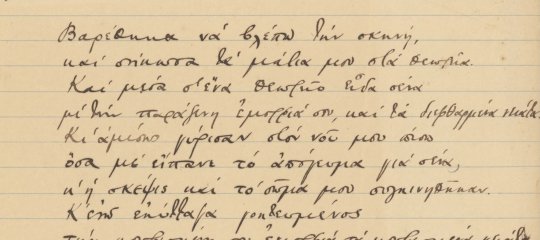Sin, Suffering, and the Search for Belonging: George Vizyenos's Literary World by Yena Kwak
Introduction
George Vizyenos (1849–1896) stands as a seminal figure in modern Greek literature, adeptly weaving personal experience with historical and cultural reflections in his fiction. His narratives delve into the intricate landscapes of memory, loss, and belonging, echoing broader themes of Greek identity and diaspora. This essay examines My Mother's Sin through the lenses of border writing, memory, and loss, alongside the quest for belonging, drawing comparisons with the thematic and narrative elements of his other notable works, including The Only Journey of His Life, Who Was My Brother's Murderer?, and Moskov Selim.1 By expanding the discussion to include these additional works, the analysis aims to provide a more comprehensive understanding of Vizyenos’s literary contribution and his engagement with themes of displacement, trauma, and national identity.
Vizyenos's Life and Historical Context
Born in the town of Vize in Eastern Thrace, then under Ottoman rule, George Vizyenos's early life was marked by displacement and familial loss. His upbringing in a region characterized by a confluence of cultures and languages profoundly influenced his literary voice. The 19th century was a transformative period for Greece, emerging from the shadows of the War of Independence and grappling with the formation of a national identity. This era of cultural and political flux is mirrored in Vizyenos's works, which often explore themes of fragmentation and the search for self-definition.
Vizyenos's educational journey took him from Constantinople to Germany, where he immersed himself in European literary movements, particularly Romanticism and Realism.2 These influences are evident in his narrative techniques, which blend emotional depth with a keen observation of societal dynamics. His bilingual and bicultural existence—navigating between Demotic and Katharevousa Greek—further underscores his engagement with linguistic and cultural boundaries. His dissertation on children's psychology reflects his early interest in psychological depth, which later manifests in his literary works.
In the broader context of Greek literature, Vizyenos was a pioneer in shifting from grand historical epics to intimate psychological realism. His stories often center on personal trauma and national displacement, reflecting the complexities of a society in transition. As Mackridge notes, "Vizyenos stands at the crossroads of Greek literary tradition and European realism, negotiating a unique space for psychological exploration in Greek prose."3
Narrative Features in My Mother's Sin and The Only Journey of His Life
Vizyenos's narrative style is characterized by its introspective depth and psychological complexity. In My Mother's Sin, the story unfolds through a first-person perspective, with the narrator reflecting on his childhood and his mother's concealed guilt. The mother's internal struggle becomes the focal point, and her eventual confession serves as a cathartic release, both for herself and her son. This dynamic allows readers to engage deeply with themes of guilt, redemption, and the enduring impact of past actions.
The non-linear structure of the narrative, interweaving past and present, mirrors the mother's fragmented psyche. Her memories intrude upon her present reality, illustrating the inescapable nature of her remorse. This temporal fluidity not only reflects her internal turmoil but also emphasizes the broader theme of how past sins continue to influence the present. This technique is similarly employed in The Only Journey of His Life, where the protagonist gradually realizes that the fairy tales his grandfather told him were fabrications, leading to a loss of innocence and a confrontation with reality.4
A similar interplay between past and present appears in Who Was My Brother's Murderer?, where the protagonist embarks on a journey to uncover a personal and moral truth. It focuses on the narrator’s inner journey of grappling with guilt and the possibility that he may have indirectly caused his brother's murder, which is more about psychological reflection and self-questioning.5 The psychological depth of the characters is central to Vizyenos’s storytelling, revealing how past traumas shape the present. Moskov Selim, another of his seminal works,is set during the Ottoman period and centers around a character named Selim, a Greek Muslim living in Constantinople. Selim is a young man who struggles with his identity, as he is caught between his Greek and Ottoman heritage, and experiences feelings of alienation and cultural confusion. It explores themes of cultural hybridity and identity conflict, offering another perspective on belonging and displacement. The story is deeply tragic, highlighting the difficulties of living in a time when ethnic and religious tensions are high, and individuals are forced to navigate their personal identity in a world of social divisions.These novels are all pointing at the author Vizyenos himself.
Motifs of Redemption and Atonement
Atonement emerges as a central motif in My Mother’s Sin, embodied in the mother's relentless efforts to care for others as a means of compensating for her perceived moral failure. The novel’s uniqueness emerges from the fact that the mother herself is the sinner, which contrasts with Vizyenos’s other works where women often serve as moral judges or victims. Here, she is the central figure of transgression and redemption. Her dedication to her ailing daughter, Annio, and subsequent acts of caregiving are driven by an overwhelming sense of guilt for neglecting her dying child in the past. This self-imposed penance transforms her into a figure of self-sacrifice, whose every action is motivated by the desire for redemption. This characterization of the mother as both sinner and saint complicates traditional moral binaries, as her sin arises not from malice but from human weakness and love distorted by circumstance.6 In this sense, Vizyenos presents a deeply human and sympathetic view of sin, one that acknowledges the complexity of moral failings and the emotional burdens they carry.
This theme of redemption through suffering is also prominent in The Only Journey of His Life, where the grandfather’s final journey symbolizes a quest for closure and understanding. His storytelling serves as a means of processing his own regrets and imparting wisdom to his grandson. The grandson’s realization of the fabricated nature of these tales represents a loss of innocence and a deeper comprehension of life’s complexities. This mirrors the mother’s journey in My Mother’s Sin, where her path to atonement is fraught with emotional turmoil and an unending struggle for absolution. The burden of guilt manifests as a psychological torment that defines her existence, making redemption an ongoing process rather than a moment of resolution. Unlike traditional narratives of sin and redemption where a singular act of penance is sufficient for moral cleansing, Vizyenos portrays atonement as a lifelong struggle, reinforcing the inescapable weight of past mistakes.
Religious undertones permeate both narratives, emphasizing the moral weight of past sins and the arduous path to redemption. In Orthodox Christianity, suffering is often viewed as a means of spiritual purification, and Vizyenos imbues his characters with this sensibility. The mother’s suffering is not merely self-imposed but is also shaped by societal expectations that dictate the role of women as bearers of familial and moral responsibility. This interplay between personal guilt and communal judgment underscores the broader cultural context in which Vizyenos’s works operate. Unlike male figures in his stories, who tend to internalize their struggles with guilt, the mother externalizes hers through acts of perpetual caregiving, thereby transforming her sorrow into a socially visible act of penitence. This dynamic reflects the gendered dimensions of redemption, where women are expected to atone through self-sacrifice, while men engage in more introspective and isolated battles with guilt.
Moreover, the motif of atonement in My Mother’s Sin is intricately linked to the concept of memory and its role in shaping identity. The mother’s sin is not simply a single past event but an ever-present force that dictates her actions, illustrating how memory can function as both a source of remorse and a path to redemption. The nonlinear structure of the narrative reinforces this notion, as past and present constantly intertwine, making the mother’s suffering inescapable. Her inability to move beyond her past mistakes underscores the psychological realism of Vizyenos’s writing, portraying guilt as an enduring force rather than a momentary affliction.
This exploration of redemption extends beyond the individual to encompass broader societal and existential concerns. In Who Was My Brother’s Murderer?, the protagonist embarks on a journey to uncover a personal and moral truth, grappling with guilt and responsibility in a manner similar to the mother’s experience in My Mother’s Sin. Both characters exist in states of perpetual self-questioning, seeking redemption but never fully attaining it. This unresolved nature of atonement in Vizyenos’s works speaks to the complexity of moral reckoning, highlighting that true redemption is often elusive and burdened by the weight of memory.
Ultimately, Vizyenos’s treatment of redemption and atonement challenges simplistic notions of sin and virtue. By portraying his characters’ struggles with psychological depth and emotional nuance, he offers a profound meditation on human fallibility and the intricate ways in which guilt and memory shape identity. His narratives suggest that redemption is not a linear process but a lifelong negotiation between past actions and present attempts at reconciliation, making his works enduringly relevant in discussions of morality, psychology, and literary realism.
Sin and the Role of Women
Women, especially mothers, are held to impossible moral standards and must atone for their mistakes in extreme ways. In Orthodox Christian traditions, mothers are the ultimate figures of love and sacrifice, but this novel complicates that image: what happens when a mother fails?
In the world of George Vizyenos's narratives, the figure of the woman, particularly the mother, is inextricably linked to the moral and emotional core of the story. The theme of sin, especially as it pertains to women, reveals the intense societal and religious expectations placed on them, particularly in the context of Orthodox Christian Greece. In this cultural and moral framework, women, and mothers in particular, are expected to embody purity, sacrifice, and selflessness. Yet, Vizyenos complicates these expectations by presenting female characters who grapple with sin, guilt, and redemption in deeply personal and often contradictory ways.
In My Mother’s Sin, the title itself foreshadows the central dilemma faced by the mother: the weight of sin and the impossibility of moral redemption in the eyes of society. This narrative revolves around the mother’s internal conflict after she fails to protect her dying child, an act that becomes the central sin for which she must atone. Unlike the traditional roles of women in Greek literature as bearers of moral guidance, purity, and compassion, this mother is positioned as both sinner and saint. Her transgression is not one of malice or evil intent but one borne out of weakness, human frailty, and an overwhelming love for her child—yet still deemed unforgivable by herself, and, to some degree, by society.
The notion of self-sacrifice is central to the mother's journey in My Mother's Sin. Rather than a single act of atonement, she sacrifices her life through perpetual acts of caregiving. Her caregiving is not only a way to redeem herself but also an attempt to erase the stain of her sin in the eyes of those around her. Her suffering is both a personal penance and a public display of her willingness to endure pain for the sake of others. It’s as though she is trapped within a moral labyrinth, where no act of self-sacrifice is enough to rid her of the guilt that haunts her. In Orthodox Christian theology, women are often held to higher moral standards, expected to embody divine love, charity, and sacrifice. The idealized image of the mother as a selfless, nurturing figure is deeply ingrained in the culture, yet this image becomes distorted when the mother in My Mother's Sin is unable to live up to her expected role. The tension between the ideal and the reality of her motherhood highlights the paradox of sin and forgiveness within the framework of societal expectations.
Interestingly, this theme of female sin and redemption is not limited to the mother in My Mother's Sin. In Who Was My Brother's Murderer?, a similar dynamic plays out, though in a different context. The mother in this story is also a figure who embodies moral responsibility and is deeply affected by the actions of her children. Here, the narrator struggles with guilt over his brother's death, and the mother serves as a contrasting figure of moral clarity, demanding justice and retribution. The mother’s desire for justice underscores the importance of family honor, a theme that links the role of women to the concept of collective morality. In this way, the mother is not just a private figure of moral judgment but a representative of a broader societal expectation that women uphold family and cultural values. Her role becomes one of moral authority, as she demands that the male characters act in ways that align with these values.
In Moskov Selim, the figure of the woman, though not as central as in the previous works, also plays an important role in the protagonist’s struggle with identity. The Greek Muslim character, Selim, finds himself caught between two worlds—his Greek heritage and his Ottoman identity—and is often subjected to the moral expectations placed on women, particularly in the context of family and honor. Selim’s experiences with women reflect the cultural constraints that both men and women navigate in the complex landscape of the Ottoman Empire.
The connection between gender roles and the theme of sin is not unique to mothers in Vizyenos’s works; it permeates the broader portrayal of women. Women are frequently shown as figures who must bear the weight of moral responsibility not only for their own actions but also for the actions of their families. This creates a dynamic where female characters are seen as both victims and agents of morality, existing within a structure that demands they fulfill impossible moral ideals.
Border Writing in My Mother's Sin and The Only Journey of His Life
The concept of border writing—the experience of existing between multiple cultural, linguistic, or psychological boundaries—serves as a central theme in many of Vizyenos’s narratives, where the blending of Greek folklore with European literary techniques creates a layered exploration of identity and belonging. In My Mother’s Sin, the protagonist is ensnared in a complex web of emotional and moral dilemmas, particularly the boundaries of guilt and atonement. His mother's relentless effort to atone for the loss of her child places her in a precarious, liminal space, where she is neither fully redeemed nor condemned. This moral ambiguity reflects the broader tension between the past and present, reality and memory, blurring those distinctions as the narrative unfolds. The fragmented sense of identity that emerges from this dynamic is a common experience for individuals caught between different cultural worlds—those navigating transitions between traditions or nations. In Who Was My Brother’s Murderer?, similar themes of guilt, alienation, and the fractured self are explored. The narrator is trapped in a liminal space, haunted by uncertainty, constantly questioning his identity and moral position. This fragmentation of self is symbolized by the narrative structure, which moves fluidly between past and present, memory and reality, thus reflecting the instability of identity that those living in cultural borderlands often face.
In The Only Journey of His Life, the idea of border writing manifests in both physical and existential terms, as the protagonist embarks on a metaphorical journey that spans a range of contrasts: from the city to the village, from reality to fantasy, from morality to literary abstraction, from oral storytelling to written narrative, from voice to silence, and ultimately from life to death. Each shift illustrates the fluid and often precarious nature of personal and cultural identity, resonating deeply with Vizyenos’s own experience of straddling the boundaries of Greece and Europe, tradition and modernity. The novel reflects the disorienting nature of cultural transition, where boundaries are not fixed, and identity is constantly in flux.7 This notion of border writing also intersects with themes of diaspora, as seen in the character of Moskov Selim. Selim is portrayed as a "border" figure, embodying the alienation and fragmentation typical of those caught between conflicting cultural spheres.8 Much like Vizyenos himself, who never fully felt he belonged to one singular place or culture, Selim is a metaphor for the diasporic experience, where national and personal identity are in constant negotiation. His struggle embodies the psychological effects of displacement, a theme deeply embedded in diaspora literature. The conflict between personal and national identity, where loyalties are torn between competing cultural influences and external perceptions, mirrors Vizyenos’s own complex relationship with his heritage. In Moskov Selim, the portrayal of Greek communities within the Ottoman Empire—forever suspended between cultures—becomes a broader allegory for Vizyenos’s own sense of belonging, caught between Greece, the Ottoman Empire, and Europe. This perpetual state of cultural displacement, where one is never fully accepted or at home in any particular space, underscores the existential struggle that defines both the author’s and Selim’s lives.
Conclusion
Through My Mother’s Sin, The Only Journey of His Life, and other key works such as Who Was My Brother's Murderer? and Moskov Selim, Vizyenos crafts narratives that transcend personal experience, reflecting broader themes of border writing, memory, loss, and the search for belonging. His works resonate as deeply psychological and historical explorations of the Greek condition, capturing the emotional turmoil of a people and a nation in transition. By blending realism with psychological depth, he provides a compelling meditation on guilt, redemption, and the inescapable weight of the past.
Vizyenos’s engagement with themes of displacement and identity crisis situates his work within the broader spectrum of diaspora literature. As a Greek writer shaped by the cultural interplay of the Ottoman and European worlds, Vizyenos conveys the anxieties of existing between two realms. This liminality is evident in the wandering, often fragmented narratives of his protagonists, who grapple with the impossibility of fully belonging to a single place or identity. The Only Journey of His Life, for example, is not simply a story of a physical voyage but an existential journey towards self-realization, ultimately underscoring the fundamental instability of identity.
Another significant contribution of Vizyenos’s work is his ability to merge folklore with literary sophistication. His narratives, while rooted in Greek oral traditions, employ intricate psychological depth that aligns them with European literary movements such as Romanticism and Realism. This fusion of storytelling traditions makes his works both culturally specific and universally resonant, enabling his literature to serve as a bridge between past and modern literary sensibilities.
In conclusion, Vizyenos’s literary legacy is marked by his exploration of guilt, memory, and identity within a framework that merges personal trauma with collective history. His nuanced portrayal of psychological struggles and moral dilemmas, particularly as they relate to sin and redemption, highlights his ability to capture the essence of human suffering and resilience. His works continue to be studied not only as reflections of 19th-century Greek society but also as timeless explorations of existential and psychological conflicts. By blending realism with introspective depth, he has left an indelible mark on Greek literature, positioning himself as a crucial figure in the evolution of modern Greek narrative traditions.
Bibliography
Beaton, Roderick. An Introduction to Modern Greek Literature. Oxford University Press, 1999.
Dimadis, Konstantinos. "The Narrative Techniques of Vizyenos." Journal of Modern Greek Studies, vol. 7, no. 2 (1990): 147-162.
Kyriakidou, Dina. Mothers, Guilt, and Suffering in Greek Literature. Routledge, 2015.
Papadimitriou, Maria. The Liminal Subject: Border Writing in Greek Literature. Palgrave Macmillan, 2020.
Tziovas, Dimitris. Greek Modernism and Beyond. Rowman & Littlefield, 1997.
Vizyenos, Georgios. Η αμαρτία της μητρός μου (My Mother's Sin). First published in 1883.
——. Ποιος ήτον ο φονεύς του αδελφού μου (Who Was My Brother’s Murderer?). First published in 1883.
——. Μόσκοβ Σελήμ (Moskov Selim). First published in 1895.
——. Διηγήματα (Short Stories). Edited by Linos Politis. Estia, 1974.
- Εισέλθετε στο σύστημα για να υποβάλετε σχόλια










